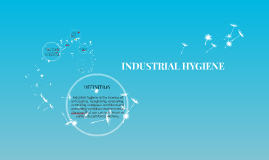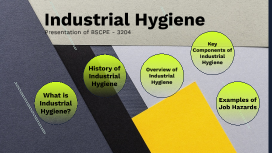INDUSTRIAL HYGIENE
Transcript: Industrial Hygiene Presentation of BSCPE - 3204 What is Industrial Hygiene? What is Industrial Hygiene? Industrial hygiene is the science of anticipating, recognizing, evaluating, and controlling workplace conditions that may cause worker's injury or illness. Industrial hygienists use environmental monitoring and analytical methods to detect the extent of worker exposure and employ engineering, work practice controls, and other methods to control potential health hazards. History of Industrial Hygiene History of Industrial Hygiene Fourth century BC when Hippocrates - noted lead toxicity in the mining industry. First century AD when Pliny the Elder - a Roman scholar, perceived health risks to those working with zinc and sulfur. - He devised a face mask made from an animal bladder to protect workers from exposure to dust and lead fumes. Second century AD when Galen - the Greek physician accurately described the pathology of lead poisoning and also recognized the hazardous exposures of copper miners to acid mists. 1556 when Agricola - the German scholar , advanced the science of industrial hygiene even further when in his book De Re Metallica, he described the diseases of miners and prescribed preventive measures. --> 1700 when Bernardo Ramazzini - known as the "father of industrial medicine" -book on industrial medicine, De Morbis Artificum Diatriba (The Diseases of Workmen). The book contained accurate descriptions of the occupational diseases of most of the workers of his time. 1743 when Ulrich Ellenborg - published a pamphlet on occupational diseases and injuries among gold miners. 18th century when Percival Pott - as a result of his findings on the insidious effects of soot on chimney sweepers, was a major force in getting the British Parliament to pass the Chimney-Sweepers Act of 1788. --> 20th century when Dr. Alice Hamilton - led efforts to improve industrial hygiene. She observed industrial conditions first hand and startled mine owners, factory managers, and state officials with evidence that there was a correlation between worker illness and their exposure to toxins. States passed the first workers' compensation laws in 1911. 1913, the New York Department of Labor and the Ohio Department of Health established the first state industrial hygiene programs. The U.S. Congress has passed three landmark pieces of legislation relating to safeguarding worker's health: --> the Metal and Nonmetallic Mines Safety Act of 1966, the Federal Coal Mine Safety and Health Act of 1969, and the Occupational Safety and Health Act of 1970 (Act). Today, nearly every employer is required to implement the elements of an industrial hygiene and safety, occupational health, or hazard communication program and to be responsive to the Occupational Safety and Health Administration (OSHA) and the Act and its regulations. Overview of Industrial Hygiene Overview of Industrial Hygiene Industrial hygiene, as stated above, is concerned with identifying, evaluating, and controlling real or potential workplace environmental stressors or hazards that can affect the wellbeing of workers and community members. It is sometimes called Occupational Hygiene, Occupational Health or Workplace Health. Ideally, hazards are identified and controlled when a workplace is being planned, when conditions or processes change, or through yearly reviews, before they become an issue for workers. --> Industrial hygienist The role of an industrial hygienist is to “anticipate health and safety concerns and design solutions to prevent them. They are the guardians of workplace safety, applying science to identify and solve health and safety problems. Industrial hygienists also unite management, workers, and all segments of a company behind the common goal of health and safety.” An industrial hygienist will use rigorous scientific methods to evaluate and control hazards in the workplace, including risk assessment tools and information, such as Safety Data Sheets, which are put together by chemical manufacturers and contain detailed information about each chemical. ERGONOMICS Key Components of Industrial Hygiene is to reduce stress and eliminate injuries associated with bad posture, overuse of muscles, and repeated tasks. Ergonomics can be improved through solutions such as changing the chairs or keyboards office workers use, introducing tools to reduce repetitive tasks, or limiting time on certain jobs. Noise Long-term exposure to noise – both wanted and unwanted sound – can lead to hearing loss for workers. Noise issues can be addressed in several ways, including designing a facility to minimize noise, separating workers from noisy machinery as much as possible, and using devices, such as ear muffs or ear plugs, to protect workers. Noise Temperature Temperature Both high and low temperatures can cause problems for workers. If temperatures are too high, workers are vulnerable to heat stroke or heat exhaustion; heat stroke is a medical emergency that requires Indoor

















